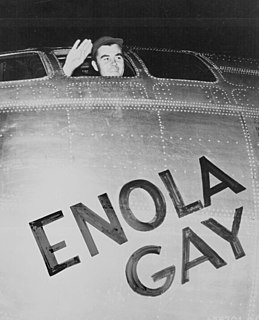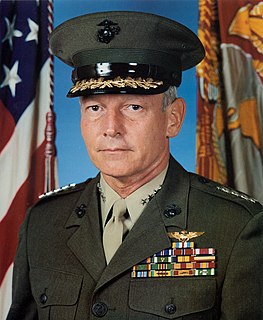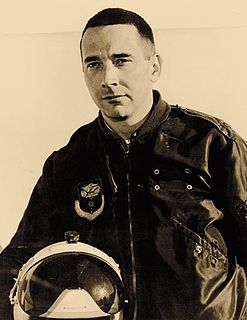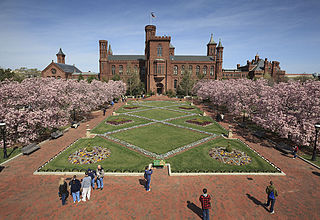The National Air and Space Museum Film Archives, part of the Archives Division at the National Air and Space Museum, Smithsonian Institution, holds over 20,000 films documenting the history of aviation and space flight.
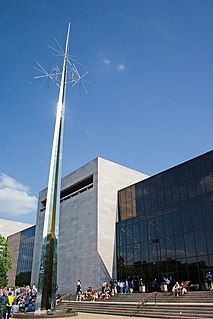
The National Air and Space Museum of the Smithsonian Institution, also called the Air and Space Museum, is a museum in Washington, D.C. It was established in 1946 as the National Air Museum and opened its main building on the National Mall near L'Enfant Plaza in 1976. In 2018, the museum saw approximately 6.2 million visitors, making it the fifth most visited museum in the world, and the second most visited museum in the United States. The museum contains the Apollo 11 command module, the Friendship 7 capsule which was flown by John Glenn, Charles Lindbergh's Spirit of St. Louis, the Bell X-1 which broke the sound barrier, the model of the starship Enterprise used in the science fiction television show Star Trek: The Original Series, and the Wright brothers' airplane near the entrance.

The Smithsonian Institution, also known simply as the Smithsonian, is a group of museums and research centers administered by the Government of the United States. It was founded on August 10, 1846, "for the increase and diffusion of knowledge". The institution is named after its founding donor, British scientist James Smithson. It was originally organized as the "United States National Museum", but that name ceased to exist as an administrative entity in 1967.

Aviation, or air transport, refers to the activities surrounding mechanical flight and the aircraft industry. Aircraft includes fixed-wing and rotary-wing types, morphable wings, wing-less lifting bodies, as well as lighter-than-air craft such as balloons and airships.
The Film Archives is located at the Steven F. Udvar-Hazy Center in Chantilly, Virginia, where it moved in 2011 from its previous location in the National Air and Space Museum (NASM) building on the National Mall. [1] The collections are available for research, though requests must be made in advance. [2]

The Steven F. Udvar-Hazy Center, also called the Udvar-Hazy Center, is the Smithsonian National Air and Space Museum (NASM)'s annex at Washington Dulles International Airport in the Chantilly area of Fairfax County, Virginia, United States. It holds numerous exhibits, including the Space Shuttle Discovery and the Enola Gay.

Chantilly is a census-designated place (CDP) in western Fairfax County, Virginia, United States. The population was 23,039 at the 2010 census. Chantilly is named after an early-19th-century mansion and farm, which in turn took the name of an 18th-century plantation that was located in Westmoreland County, Virginia. The name "Chantilly" originated in France with the Château de Chantilly, about 25 miles north of Paris.
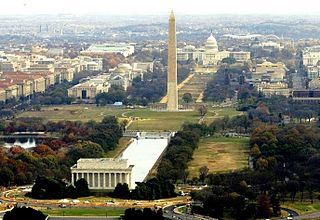
The National Mall is a landscaped park within the National Mall and Memorial Parks, an official unit of the United States National Park System. It is located near the downtown area of Washington, D.C., the capital city of the United States, and is administered by the National Park Service (NPS) of the United States Department of the Interior.
NASM Film Archives' collections range from the early days of flight to space exploration. [2] Totaling more than 700,000 feet of motion picture film as well as videotape, [3] the collections include edited documentaries, instructional films, promotional films, home movies, interviews and outtakes. [1] [4] The earliest item in the collection is a 1909 test flight of the Wright Military Flyers at Ft. Myer, Virginia. [5]

A home movie is a short amateur film or video typically made just to preserve a visual record of family activities, a vacation, or a special event, and intended for viewing at home by family and friends. Originally, home movies were made on photographic film in formats that usually limited the movie-maker to about three minutes per roll of costly camera film. The vast majority of amateur film formats lacked audio, shooting silent film.

Flight testing is a branch of aeronautical engineering that develops and gathers data during flight of an aircraft, or atmospheric testing of launch vehicles and reusable spacecraft, and then analyzes the data to evaluate the aerodynamic flight characteristics of the vehicle in order to validate the design, including safety aspects.

The Wright Model A was an early aircraft produced by the Wright Brothers in the United States beginning in 1906. It was a development of their Flyer III airplane of 1905. The Wrights built about seven Model As in their bicycle shop during the period 1906–1907 in which they did no flying. One of these was shipped to Le Havre in 1907 in order to demonstrate it to the French. The Model A had a 35-horsepower (26 kW) engine and seating for two with a new control arrangement. Otherwise it was identical to the 1905 airplane. The Model A was the first aircraft that they offered for sale, and the first aircraft design to enter serial production anywhere in the world. Apart from the seven machines the Wrights built themselves in 1906–1907, they sold licences for production in Europe with the largest number of Model As actually being produced in Germany by Flugmaschine Wright GmbH, which built about 60 examples.
The collections include:
- Keystone Aircraft Corporation Collection (1926–34)
- Seymour Collection (1926–34)
- Lewis E. Reisner Collection (1929–38)
- World Trip Collection (1935–36)
- We Saw It Happen (1953)
The Seymour Collection is a collection of philatelic material relating to the development and operation of the de Havilland Comet aircraft, that forms part of the British Library Philatelic Collections. The collection was formed by Kenneth Seymour and donated to the library by his daughter Yvonne Wallace and his son Derek Seymour in 2003.
